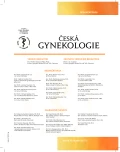Trojčetné těhotenství se smíšenou chorionicitou po léčbě IVF: je fetoredukce vhodná?
Authors:
A. Sobek jr. 1,3; M. Procházka 2; E. Klásková 3,4; B. Zbořilová 3; M. Lubušký 1; A. Sobek 3
Authors‘ workplace:
Department of Obstetrics and Gynaecology, Palacký University Hospital, Olomouc, Czech Republic
prof. MUDr. R. Pilka, Ph. D.
1; Department of Medical Genetics, Palacký University Hospital, Olomouc, Czech Republic
prof. MUDr. M. Procházka, Ph. D.
2; Fertimed Infertility Center, Olomouc, Czech Republic, doc. MUDr. A. Sobek, Ph. D.
3; Department of Paediatrics, Palacký University Hospital, Olomouc, Czech Republic
prof. MUDr. V. Mihál, Ph. D.
4
Published in:
Ceska Gynekol 2017; 82(2): 118-121
Overview
Cíl studie:
Zvýšený výskyt monozygotních vícečetných těhotenství po léčbě asistovanou reprodukcí je tématem mnoha studií. V této práci popisujeme průběh dvou trojčetných těhotenství po transferu dvou embryí v rámci léčby metodami asistované reprodukce, u kterých byla zvolena různá strategie.
Typ studie:
Case report.
Název a sídlo pracoviště:
Porodnicko-gynekologická klinika FNOL, Olomouc.
Metodika:
Pacientka A byla 30letá, 0 para, a pacientka B byla 32letá, I para. U obou bylo v I. trimestru diagnostikováno trojčetné těhotenství se smíšenou chorionicitou – biamniální monochoriální dvojčata a jednočetné těhotenství. Po podrobné konzultaci se obě rozhodly pro odlišnou strategii vedení těhotenství.
Výsledky:
U pacientky A byla monozygotní komponenta ukončena fetocidou v 15. týdnu gravidity a pacientka porodila zbylý plod v termínu bez dalších komplikací. Pacientka B se rozhodla pro observaci těhotenství bez další intervence. Těhotenství bylo komplikováno rozvojem těžké mateřské morbidity a ukončeno císařským řezem ve 28. týdnu gravidity po úmrtí jednoho z plodů.
Závěr:
Párům s troj- a vícečetným těhotenstvím by měla být nabídnuta možnost fetoredukce. U trojčat se smíšenou chorionicitou je vhodné zvážit redukci monochoriální komponenty, a předejít tak riziku, které navíc představuje sdílená placenta.
Klíčová slova:
embryo transfer, in vitro fertilizace, trojčetná gravidita, fetoredukce
Sources
1. Abel, J., Flock, A., Gembruch, U. Expectant management versus multifetal pregnancy reduction in higher order multiple pregnancies containing a monochorionic pair and a review of the literature. A. Arch Gynecol Obstet, 2016, 5, p. 1167–1173.
2. Adegbite, L., Ward, S., Bajora, R. Perinatal outcome of quadruplet pregnancies in relation to chorionicity. J Perinatol, 2007, 27, p. 15–21.
3. Bajoria, R., Ward, S., Adegbite, L. Comparative study of perinatal outcome of dichorionic and trichorionic iatrogenic triplets. Am J Obstet Gynecol, 2006, 194, p. 415–424.
4. Berkowitz, RL., Lynch, L., Chitkara, U., et al. Selective reduction of multiple pregnancies in the first trimester. N Engl J Med, 1988, 318, p. 1043–1047.
5. Jirsová, S., Mardešić, T., Hulvert, J., Muller, P. Zhoršuje redukce vícečetné gravidity perinatální výsledky u dvoučetných gravidit? Čes Gynek, 2000, 65, s. 230–235.
6. Geipel, A., Berg, C., Katalinic, A., et al. Prenatal diagnosis and obstetric outcomes in triplet pregnancies in relation to chorionicity. BJOG, 2005, 112, p. 554–558.
7. Gibson, J., Cameron, A. Complications of monochorionic twins. Paediat Child Health, 2008, 18, p. 568–573.
8. Gonen, Y., Blankier, J., Casper, RF. Transvaginal ultrasound in selective embryo reduction for multiple pregnancy. Obstet Gynecol, 1990, 75, p. 720–722.
9. Has, R., Kalelioglu, I., Corbacioglu, A., et al. Bipolar cord coagulation in the management of complicated monochorionic twin pregnancies. Fetal Diagn Ther, 2014, 36, 3, p. 190–195.
10. Chaveeva, P., Kosinski, P., Puglia, D., et al. Trichorionic and dichorionic triplet pregnancies at 10–14 weeks: outcome after embryo reduction compared to expectant management. Fetal Diagn Ther, 2013, 34, p. 199–205.
11. Chow, J., Benson, B., Racowsky, C., et al. Frequency of a monochorionic pair in multiple gestations. Relationship to mode of conception. J Ultrasound Med, 2001, 20, p. 757–764.
12. Itskovitz, J., Boldes, R., Thaler, I., et al. First trimester selective reduction in multiple pregnancy guided by transvaginal sonography. J Clin Ultrasound, 1990, 18, 4, p. 323–327.
13. Luke, B., Brown, MB., Wantman E., Stern JE. Factors associated with monozygosity in assisted reproductive technology pregnancies and the risk of recurrence using linked cycles. Fertil Steril, 2014, 101, 3, p. 683–689.
14. Morlando, M., Ferrara, L., D‘Antonio, F., et al. Dichorionic triplet pregnancies: risk of miscarriage and severe preterm delivery with fetal reduction versus expectant management. Outcomes of a cohort study and systematic review. BJOG, 2015, 122, 6, p. 1053–1060.
15. Pandian, Z., Templeton, A., Serour, A., Bhattacharya, S. Number of embryos for transfer after IVF and ICSI: a Cochrane review. Hum Reprod, 2005, 20, 10, p. 2681–2687.
16. Rong, L., et al. Retain singleton or twins? Multifetal pregnancy reduction strategies in triplet pregnancies with monochorionic twins. EJOG, 2013, 167, p. 146–148.
17. Sobek, A. jr., Zbořilová, B., Procházka, M., et al. High incidence of monozygotic twinning after assisted reproduction is related to genetic information, but not to assisted reproduction technology itself. Fertil Steril, 2015, 3, p. 756–760.
18. Van de Mheen, L., Everwijn, SM., Haak, MC., et al. Outcome of Multifetal Pregnancy Reduction in Women with a Dichorionic Triamniotic Triplet Pregnancy to a Singleton Pregnancy: A Retrospective Nationwide Cohort Study. Fetal Diagn Ther, 2015.
19. Wimalasundera, R. Selective reduction and termination of multiple pregnancies. Semin Fetal Neonatal Med, 2010, 15, 6, p. 327–335.
20. Yovel, I., Yaron, Y., Amit, A., et al. Embryo reduction in multifetal pregnancies using saline injection: comparison between the transvaginal and the transabdominal approach. Hum Reprod, 1992, 7, 8, p. 1173–1175.
Labels
Paediatric gynaecology Gynaecology and obstetrics Reproduction medicineArticle was published in
Czech Gynaecology

2017 Issue 2
Most read in this issue
- Inverze dělohy
- Těhotenství a porod žen s idiopatickými střevními záněty
- Český překlad a validace dotazníku kvality pohlavního života u žen s prolapsem pánevních orgánů či inkontinencí moči nebo stolice – PISQ-IR
- Ultrazvuková diagnostika syndromu fetální zánětlivé odpovědi u žen s předčasným odtokem plodové vody
